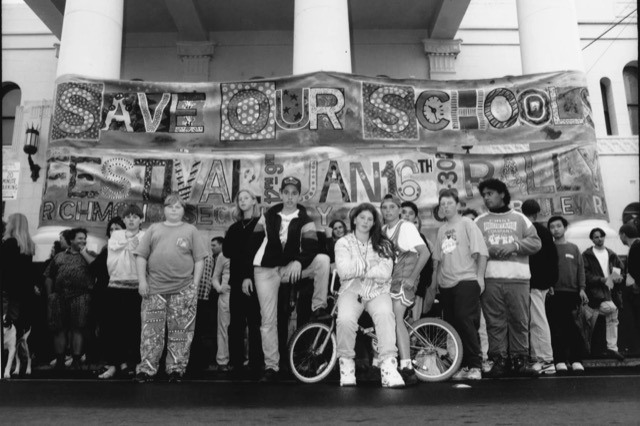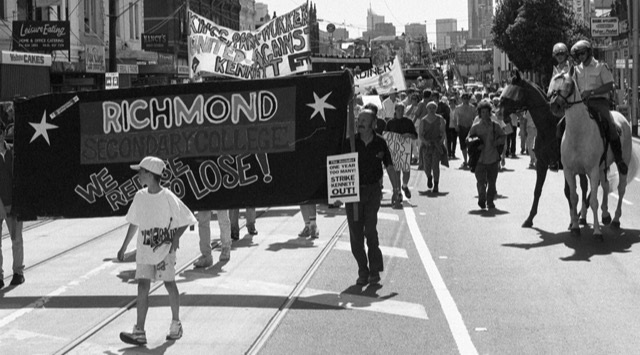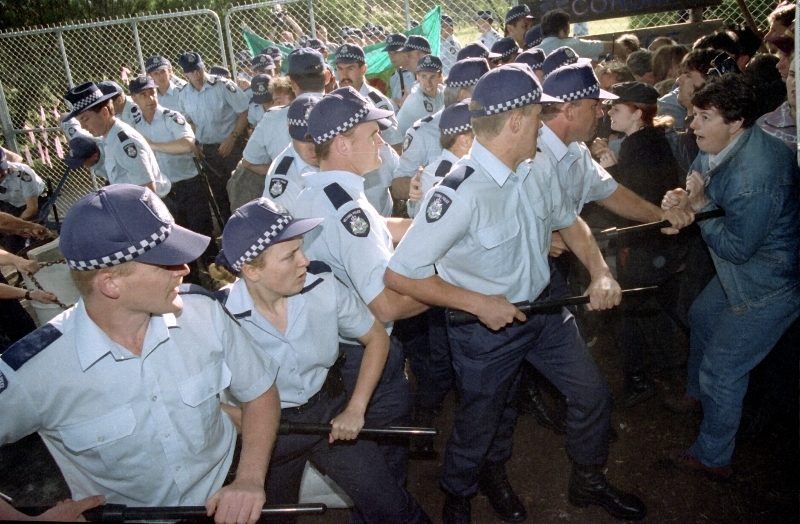The fight for Richmond’s rebel school
In the early 1990s, Liberal Premier Jeff Kennett launched a savage attack on working-class Victorians. A slew of privatisations, cuts to public services and attacks on working conditions hit working-class communities hard. Public education was a major target, with hundreds of schools on the chopping block.
Kennett’s cuts and closures outraged working-class Victorians, who looked for ways to resist. At Richmond Secondary College, one of the schools in Kennett’s crosshairs, teachers took matters into their own hands. They drew community members and activists into an epic campaign that involved occupations, protests and pitched battles with police. In the end, they achieved one of the few partial victories in the fight against the Kennett government.

Richmond Secondary was just one of 150 schools named in Kennett’s first tranche of school closures. Why did it become such a bastion of struggle? One of the key differences was the presence of socialists in the school’s union sub-branch, who sprang into action even before the closures were officially announced.
Mike Naismith, the union representative at Richmond Secondary, had been a socialist and militant in the teachers’ unions since the 1960s. According to him, conservative school principals had been working with the Liberal Party even before Kennett’s election, providing input as to which schools should be slated for closure. Despite Richmond Secondary being highly valued by the working-class residents of the area, the school was a likely target for closure because of its relatively low enrolments compared to some others in the area. In the face of resistance from the school’s principal, Naismith and his colleagues set up a committee to fight the potential closure, which they invited parents and students to join.
When the announcement finally came that Richmond was to be closed, the committee immediately got to work. Naismith describes how they ripped everything off the noticeboards in the staffroom, transforming it into a campaign organising centre. They also notified the school principal—who had previously targeted Naismith and other unionists at the school for their activism—that her office was being requisitioned for organising purposes.
For the remainder of the school year, the teachers continued teaching classes despite the school’s official closure. The principal’s attempts to restore order were hopeless, as it quickly became clear that the staff were now running the show.
The occupying teachers had to withstand significant pressure from the Department of Education. Department officials were committed to enforcing Kennett’s attacks, and showed up regularly to try to remove the teachers. Kennett had also given the go-ahead for local principals to ransack the closed school for equipment. The rebel teachers used heavy chains on the school doors to keep them out.
The campaign committee didn’t limit itself to maintaining and defending the industrial occupation of the school—it understood that a broader struggle was needed to challenge Kennett successfully. The activists organised rallies down Bridge Road, the main drag in Richmond. They also packed buses with students and teachers to conduct classes outside the offices of the education minister and state parliament.

The “rebel school” quickly gained the attention of the press. It became a pole of attraction for activists and community members outraged by Kennett’s attacks. When the school year ended for summer break, the campaign swelled with volunteers.
But they also confronted some serious challenges. The campaign was determined and drew in lots of support from the community, but it was relatively isolated from the broader union movement. The teachers’ union, then the Victorian Secondary Teachers Association (VSTA), could have shut schools across the state and called on other unions for support in an effort to frustrate Kennett’s plans. But the conservative leadership of the union limited itself to only one full-day strike, which was easy for the government to ignore.
Naismith also attempted to win the support of the Victorian Trades Hall Council (VTHC), the peak union body in Victoria, for a union-supported picket of the school. This could have involved a ban on demolition or other works on the school. But like the VSTA leaders, VTHC leader John Halfpenny was reluctant to offer support. Halfpenny, once a militant Communist metalworker, was by then a member of the Labor Party with aspirations to climb its ranks, not rock the boat.
The lack of support from the union leaders put the teachers in a bind. They risked losing their jobs if they refused the dictates of the Education Department. Leading teachers like Naismith were issued transfer notices, asking them to nominate schools they’d be prepared to move to. Some refused on principle. Others were sacked.
Without broader support, the teachers could not maintain their occupation. Still, the campaign committee refused to give up the fight. Over the summer break they voted to keep the rebel school going in the new year; only it would now be run by volunteer teachers and activists.
Their ambitious plan was made possible by a groundswell of support from the community. It helped that Richmond had a rich political history, once being home to three Communist Party branches and a strong branch of the Labor Party. Naismith reported being offered a donation of $50 by a local Communist Party ex-member. Socialist groups sent representatives to the campaign meetings. A shop steward from the Carlton and United Brewery in Abbotsford got involved in the campaign because his child had been a student at the school. Even local firefighters offered their support.
The campaign also transformed many of those participating in it. Elvie Sievers was a local working-class mother whose son attended the school and who had previously been a student there herself. Naismith recalled her “natural ability to grasp injustice and inspire others to fight it”. She would develop into one of the central leaders of the campaign. Some of the school cleaners stayed and became activists. The librarian moved her caravan onto the school grounds and started living there.
But the school also needed teachers. Without any financial backing, the most the campaign committee could offer was $20 a week plus the dole. They scraped together the money for an ad in the newspaper to attract unemployed teachers. It wasn’t long before they started receiving offers from teachers keen to take part. A few were substitutes in the state system, while others just supported the campaign on principle and wanted to help.
Meanwhile, Kennett’s attacks on public education continued relentlessly. He closed hundreds more schools. The campaign committee attempted to broaden the struggle by organising a “Save our Schools” campaign, which toured around schools and other job sites to drum up opposition to Kennett’s cuts.
The rebel school managed to survive for nearly the entire school year. But as time passed, it became increasingly difficult to maintain. The campaign committee shouldered the double burden of running the school while also organising a political campaign. Funds were always lacking. Endurance was tested and morale suffered.
Right-wing pressure was also building on Kennett to crack down on the rebel school. The right understood the campaign was providing a beacon of hope in the resistance to Kennett’s anti-union agenda. The government was eager to put it to bed.
In December of 1993, after a year of the school being occupied, the state brought the boot down. Writs for up to $1 million were issued to key campaign leaders, and the police forcibly evicted the activists in dawn raids. The school was boarded up.

Debates opened up on the campaign committee about how to move forward. Should they reoccupy the school? Naismith reported hearing whispers that some teacher unionists from Mount Waverley were preparing to use bolt cutters to break back into the building. But in the end, the committee decided they lacked the numbers to maintain a new occupation against police pressure. A different strategy was needed.
Despite losing control of the school, the campaign had nevertheless pushed Kennett to reconsider his plans. Originally, Richmond Secondary was to be demolished to make way for luxury apartments. The building occupied prime real estate, just next to the Yarra River. But as a result of the pressure from the campaign, the Kennett government agreed to use the building for a new selective public school, but only for girls.
This was not what the community wanted. In the 1960s, they had fought hard for a coeducational school in the area, which led to the creation of Richmond Secondary. They were not willing to give that up for a selective school that half their children would not be able to attend.
So the campaign committee decided they would set up a picket at the school, to prevent any work from being done on it until the government agreed to reopen it as a coeducational school. Finally, in response to the forced eviction, Halfpenny and the Victorian Trades Hall Council decided to lend their support to the campaign and endorsed the picket.

But the Kennett government had other ideas. On Monday, 13 December, known in Richmond as “Bloody Monday”, around 200 police stormed the picket line. They bashed through the community activists using long batons that had not been used against civilians in years. The picket could not hold out against the brutal violence of the cops. Five people were arrested and many were injured, with three hospitalised.
The thuggery of the cops only increased support for the campaign, as even more picketers showed up the next day and continued to do so for around a week. The police continued to confront them, but resorted to dragging them away from the school one by one, which reportedly took hours.
The determined resistance forced the government and Halfpenny to the negotiating table with the campaign committee. The government agreed to create a new coeducational school in Richmond, but they left the specifics decidedly vague. Unfortunately, the campaigners felt they had little choice but to accept, as Halfpenny threatened to pull support for the picket if they refused.
Kennett had succeeded in turning the lives of so many students and school staff upside down. When the dust settled, he had closed around 350 schools and cut around 10,000 education jobs across the state.
But the campaign to save Richmond’s rebel school was not in vain. It demonstrated that resistance to neoliberal cuts was possible and could achieve tangible results. Northland Secondary College in Preston also became a rebel school and won a significant victory. After a community campaign, a successful Equal Opportunity court case—which hinged on the school’s high proportion of Indigenous students—led to the school’s reopening in 1995.
But to have a real shot at pushing back Kennett’s agenda, the unions needed to shut down workplaces around the state. There’s no doubt this was possible. On 10 November 1992, right after Kennett announced his blitz of attacks, workers took to the streets in numbers that shocked everyone. Police Superintendent Brian Casey estimated that up to 100,000 workers flooded the streets of Melbourne, with thousands more on strike statewide. But Halfpenny and other union leaders showed no interest in maintaining this campaign and offered no meaningful resistance beyond the set-piece demonstrations.
To resist Kennett, a different kind of leadership was needed—one that saw working-class power, not backroom negotiations, as the solution to every problem. This was the approach of those who led the campaign to save Richmond Secondary College, which allowed it to push far beyond where the union leaders were willing to go. And it’s the kind of leadership we’ll need to rebuild in our unions, if we’re going to push back the pro-capitalist agenda that has continued since the Kennett era.